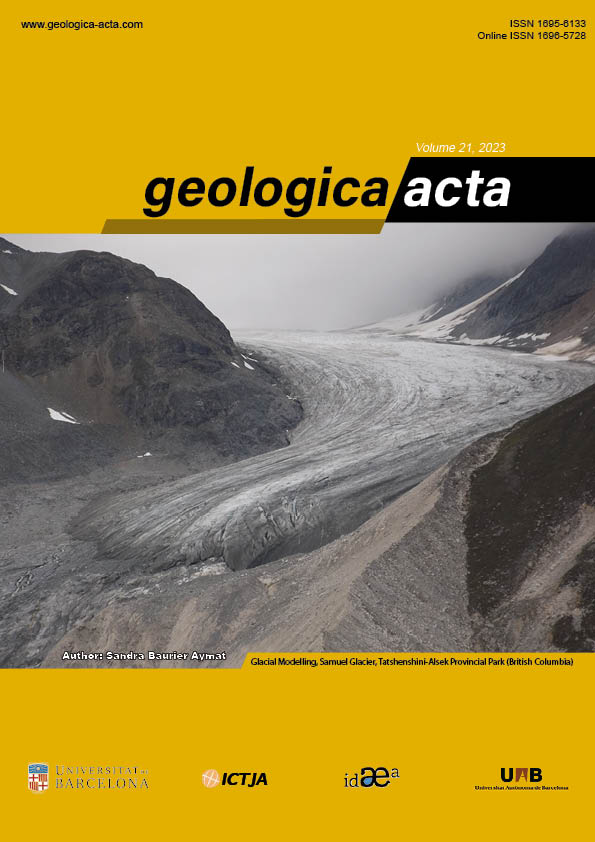New evidence for late Eocene-early Oligocene uplift of Aves Ridge and paleogeography of GAARlandia
DOI:
https://doi.org/10.1344/GeologicaActa2023.21.5Keywords:
GAARlandia, Aves Ridge, Eocene-Oligocene, Paleogeography, Biogeography, CaribbeanAbstract
The GAARlandia hypothesis has produced vigorous debate among biologists regarding whether now-submerged landforms that existed in the Caribbean region during the late Paleogene might have acted as a barrier for marine organisms and as a bridge for terrestrial biotas migrating from South America into the Greater Antilles. This concept derived from the hypothesized emergence history of the Aves Ridge. In the quarter century since GAARlandia was first proposed, new paleontological, geological and geophysical information has greatly extended the database available. Here we reaffirm that GAARlandia was a positive topographic feature from middle Eocene, and was exposed above sea level between late Eocene and early Oligocene when it facilitated biotic colonization of the northern Greater Antilles and their satellite islands, whether as a series of closely spaced islands or as a continuous peninsula projecting from northeastern South America along the crown of the rise.
References
Agnolin, F.L., Chimento, N.R., Lucero, S.O., 2019. Pre-GABI biotic connections between the Americas: an alternative model to explain the “less-splendid isolation” of South America. Revista Geológica de América Central, 61, 91-106. DOI: https://doi: 10.15517/rgac.v61i0.40089
Ali, J.R., 2012. Colonizing the Caribbean: Is the GAARlandia land-bridge hypothesis gaining a foothold? Journal of Biogeography, 39, 431-433. DOI: https://doi.org/10.1111/j.1365- 2699.2011.02674.x
Ali, J.R., Hedges, S.B., 2021. Colonizing the Caribbean: New geological data and an updated land-vertebrate colonization record challenge the GAARlandia land-bridge hypothesis. Journal of Biogeography, 00, 1-9. DOI: https://doi.org/10.1111/jbi.14234
Bock, W.D., 1972. The use of foraminifera as indicators of subsidence in the Caribbean. Caracas: Cromotik. Transactions of the 6th Caribbean Geological Conference, 439-440.
Bouysse, P., Andreief, P., Richard, M., Baubron, J.C., Mascle, A., Maury, R.C., Westercamp, D., 1985. Aves swell and northern Lesser Antilles ridge: rock-dredging results from Arcade 3 cruise. In: Mascle, A. (ed.). Caribbean geodynamics. Paris, Editorial Technip, 65-76.
Cala-Riquelme, F., Wiencek, P., Florez-Daza, E., Binford, G.J., Agnarsson, I., 2022. Island-to-Island Vicariance, FounderEvents and within-Area Speciation: The Biogeographic History of the Antillattus Clade (Salticidae: Euophryini). Diversity, 14, 224. DOI: https://doi.org/10.3390/d14030224
Cerpa, N.G., Hassani, R., Arcay, D., Lallemand, S., Garrocq, C., Philippon, M., Cornée, J.-J., Münch, P., Garel, F., Marcaillou, B., Mercier de Lépinay, B., Lebrun, J.-F., 2021. Caribbean Plate Boundaries Control on the Tectonic Duality in the Back-Arc of the Lesser Antilles Subduction Zone During the Eocene. Tectonics, 40(11), e2021TC006885. DOI: https://doi.org/10.1029/2021TC006885
Chamberland, L., Mc Hugh, A., Kechejian, S., Binford, G.J., Bond, J.E., Coddington, J., Dolman, G., Hamilton, C.A., Harvey, M.S., Kuntner, M., Agnarsson, I., 2018. From Gondwana to GAARlandia: Evolutionary history and biogeography of ogrefaced spiders (Deinopis). Journal of Biogeography, 45, 2442-2457. DOI: https://doi.org/10.1111/jbi.13431
Church, R.E., Allison, K.R., 2004. The Petroleum Potential of the Saba Bank Area, Netherlands Antilles. Search and Discovery, Article #10076, 58pp.
Clark, S.A., Levander, A., Magnani, M.B., Zelt, C.A., 2008. Negligible convergence and lithospheric tearing along the Caribbean–South American plate boundary at 64ºW. Tectonics, 27, TC6013. DOI: https://doi:10.1029/2008TC002328
Cornée, J.-J., Münch, P., Philippon, M., Boudagher-Fadel, M., Quillévéré, F., Melinte- Dobrinescu, M., Lebrun, J.F., Gay, A., Meyer, S., Montheil, L., Lallemand, S., Marcaillou, B., Laurencin, M., Legendre, L., Garrocq, C., Boucard, M., Beslier, M.-O., Laigle, M., Schenini, L., Fabre, P.-H., Antoine, P.-O., Marivaux, L., the GARANTI and ANTITHESIS Scientific Parties, 2021. Lost islands in the northern Lesser Antilles: possible milestones in the Cenozoic dispersal of terrestrial organisms between South America and the Greater Antilles. Earth Science Review 217, 103617. DOI: https://doi.org/10.1016/j.earscirev.2021.103617
Cornée, J.J., De Min, L., Lebrun, J-F., Quillévéré, F., MelinteDobrinescu, M., BouDagher-Fadel, M., Montheil, L., Marcaillou, B., Thinon, I., Mélody Philippon, M., 2023. Paleogeographic evolution and vertical motion of the central Lesser Antilles forearc since the Early Miocene: A potential driver for land fauna dispersals between the Americas. Marine and Petroleum Geology, 20pp. Last accessed: May 2023. Website: https://www.elsevier.com/locate/marpetgeo
Escalona, A., Mann, P., 2011. Tectonics, basin subsidence mechanisms, and paleogeography of the Caribbean-South American plate boundary zone. Marine and Petroleum Geology, 28, 8-39.
Fox, P.J., Schreiber, E., Heezen, B.C., 1971. The geology of the Caribbean crust: Tertiary sediments, granitic and basic rocks from the Aves ridge. Tectonophysics, 12(2), 89-109. DOI: https://doi.org/10.1016/0040-1951(71)90011-4
Garrocq, C., Lallemand, S., Marcaillou, B., Lebrun, J.-F., Padron, C., Klingelhoefer, F., Laigle, M., Münch, P., Gay, A., Schenini, L., Beslier, M.-O., Cornée, J.-J., Mercier de Lépinay, B., Quillévéré, F., BouDagher-Fadel, M., 2021. Genetic relations between the Aves Ridge and the Grenada back-arc basin, East Caribbean Sea. Journal of Geophysical Research: Solid Earth, 126, e2020JB020466. DOI: https://doi.org/10.1029/2020JB020466
Gough, D.I., 1973. Dynamic Uplift of Andean Mountains and Island Arcs. Nature Physical Science, 242, 9-41.
Hedges, S.B., 2001, Biogeography of the West Indies: An overview. In: Woods, C.A., Sergile, F.E. (eds.). Biogeography of the West Indies: Patterns and perspectives. Boca Raton, FL: CRC Press, 2nd edition, 15-33.
Hedges, S.B., 2006. Paleogeography of the Antilles and the origin of West Indian terrestrial vertebrates. Annals of the Missouri Botanical Garden, 93, 231-244.
Huber, M., Caballero, R., 2003. Eocene El Niño: evidence for robust tropical dynamics in the ‘‘hothouse’’. Science, 299, 877-881.
Iturralde-Vinent, M., 2003. A brief account of the evolution of the Caribbean seaway: Jurassic to present. In: Prothero, D., Ivany, L.C., Nesbitt, E.A. (eds.). From Greenhouse to Icehouse: The Marine Eocene-Oligocene Transition. New York, Colombus University Press, Chapter 22, 386-396.
Iturralde-Vinent, M., 2006. Meso-Cenozoic Caribbean paleogeography: implications for the historical biogeography of the region. International Geology Review, 48(9), 791-827.
Iturralde-Vinent, M., MacPhee, R.D.E., 1999. Paleogeography of the Caribbean region, implications for Cenozoic biogeography. Bulletin of American Museum Natural History, 238, 1-95.
Locke, B.D., Garver, J.I., 2005. Thermal evolution of the eastern Serrania del Interior foreland fold and thrust belt, northeastern Venezuela, based on apatite fission-track analyses. In: Avé Lallemant, H.G., Sisson, V.B. (eds.). Caribbean-South American Plate Interactions. Venezuela, Geological Society of America, 394 (Special Papers), 315-328.
MacPhee, R.D.E., Iturralde-Vinent, M.A., 1995. Origin of the Greater Antillean land mammal fauna, 1: New Tertiary fossils from Cuba and Puerto Rico. American Museum Novitates, 3141, 1-31.
MacPhee, R.D.E., Iturralde-Vinent, M.A., 2000. A short history of Greater Antillean land mammals: biogeography, paleogeography, radiations, and extinctions. Tropics, 10(1), 145-154.
MacPhee, R.D.E., Iturralde-Vinent, M.A., Gaffney, E.S., 2003. Domo de Zaza, an early Miocene vertebrate locality in south-central Cuba: With notes on the tectonic evolution of Puerto Rico and the Mona Passage. American Museum Novitates, 3394, 1-42. DOI: https://doi.org/10.1206/0003-0082(2003)394<0001:DDZAE M>2.0.CO;2
MacPhee, R.D.E., Iturralde-Vinent, M., 2005. The interpretation of Caribbean paleogeography: reply to Hedges. In: Alcover, J.A., Bover, P., (eds.). Proceedings of the International Symposium: Insular Vertebrate Evolution: The Paleontological Approach. Monografies de la Societat d’Història Natural de les Balears, 12, 175-184.
Macsotay, O., Feraza, T., 2005. Middle Eocene foreland sediments covered by late Oligocene foredeep turbidites on Margarita Island, northeaster Venezuela. Transactions of the 16th Caribbean Geological Conference, Barbados, Caribbean Journal of Earth Science, 39, 105-111.
Marivaux, L., Vélez-Juarbe, J., Merzeraud, G., Pujos, F., Viñola López, L.W., Boivin, M., Santos-Mercado, H., Cruz, E.J., Grajales, A., Padilla, J., Vélez-Rosado, K.I., Philippon, M., Léticée, J-L., Münch, P., Antoine, P-O., 2020. Early Oligocene chinchilloid caviomorphs from Puerto Rico and the initial rodent colonization of the West Indies. Proceedings Royal Society, B, 287, 20192806. DOI: http://dx.doi.org/10.1098/rspb.2019.2806
Marlowe, J.I., 1971. Dolomite, phosphorite, and carbonate diagenesis on a Caribbean seamount. Journal of Sedimentary Research, 41(3), 809-827. DOI: https://doi.org/10.1306/74D72360-2B21-11D7-8648000102C1865D
Nagle, F., 1972. Rocks from seamounts and escarpments on the Aves Ridge. Margarita (Venezuela), Transaction 6th Caribbean Geological Conference, 409-413.
Neill, I., Kerr, A.C., Hastie, A.R., Stanek, K.-P., Millar, I.L., 2011. Origin of the Aves Ridge and Dutch-Venezuelan Antilles: interaction of the Cretaceous ‘Great Arc’ and CaribbeanColombian Oceanic Plateau? Journal of the Geological Society, 168, 333-347. DOI: https://doi: 10.1144/0016-76492010-067
Nemec, M.C., 1980. A two phase model for the tectonic evolution of the Caribbean. Transaction 9th Caribbean Geological Conference. Santo Domingo (Dominican Republic), 1, 24-34.
Padron, C., Klingelhoefer, F., Marcaillou, B., Lebrun, J.-F., Lallemand, S., Garrocq, C., Laigle, M., Roest, W.R., Beslier, M.O., Schenini, L., Graindorge, D., Gay, A., Audemard, F., Münch, P., the GARANTI Cruise Team, 2021. Deep structure of the Grenada Basin from wide-angle seismic, bathymetric and gravity data. Journal of Geophysical Research: Solid Earth, 126, e2020JB020472, 36pp. DOI: https://doi.org/10.1029/2020JB020472
Philippon, M., Cornée, J.-J., Münch, P., van Hinsbergen, D.J.J., BouDagher-Fadel, M., Gailler, L., Boschman, L.M., Quillévéré, F.R., Montheil, L., Gay, A., Lebrun, J.F., Lallemand, S., Marivaux, L., Antoine, P.-O., 2020. Eocene intra-plate shortening responsible for the rise of a faunal pathway in the northeastern Caribbean realm. PLoS ONE, 15, e0241000.
Pindell, J., Kennan, L., 2009, Tectonic evolution of the Gulf of Mexico, Caribbean, and northern South America in the mantle reference frame: An update. In: James, K.H., Lorente, M.A., Pindell, J.L. (eds.). The Origin and Evolution of the Caribbean Plate. London, The Geological Society, 328 (Special Publications), 1-5.
Pinet, B., Lajat, D., Le Quellec, P., Bouysse, P., 1985. Structure of Aves Ridge and Grenada basin from multichannel seismic data. Paris, Editions Technip, Géodynamique des Caraïbes, 53-64.
Presslee, S., Slater, G.J., Pujos, F., Forasiepi, A.M., Fischer, R., Molloy, K., Mackie, M., Olsen, J.V., Kramarz, A., Taglioretti, M., Scaglia, F., Lezcano, M., Lanata, J.L., Southon, J., Feranec, R., Bloch, J., Hajduk, A., Martin, F.M., Salas Gismondi, R., Reguero, M., de Muizon, C., Greenwood, A., Chait, B.T., Penkman, K., Collins, M., MacPhee, R.D.E., 2019. Palaeoproteomics resolves sloth relationships. Nature Ecology & Evolution, 3(7), 1121-1130. DOI: 10.1038/s41559-019-0909-z. Epub 2019 Jun 6. PMID: 31171860.
Prothero, D., Ivany, L.C., Nesbitt, E.A. (eds.), 2003. From Greenhouse to Icehouse: The Marine Eocene-Oligocene Transition. Olympia (New York), August 1999, Proceedings of the Penrose Conference held 1722, Washington, Colombus University Press, XIII + 541pp
Sawyer, D., Mann, P., 2004. Cruise EW0404 on RV Maurice Ewing [Dataset]. DOI: https://doi.org/10.7284/901238
Schneider, F.J.S., Noya, J.A., Magnier, C., 2012. Model of lowmaturity generation of hydrocarbons applied to the Carupano Basin, Offshore Venezuela. In: Peters, K.E., Curry, D.J., Kacewicz, M. (eds.). Basin Modeling: New Horizons in Research and Applications. American Association of Petroleum Geologists, Hedberg Series 4, 51-69.
Tejada, J.V., Antoine, P.-O., Münch, P., Billet, G., Hautier, L., Delsuc, F., Condamine, F., in press. Bayesian total-evidence dating
revisits sloth phylogeny and biogeography: a cautionary tale on morphological clock analyses. Systematic Biology.
Tomblin, J.F., 1975. The Lesser Antilles and Aves Ridge. In: Nairn, A.E.M., Stehli, F.G. (eds.). The Gulf of Mexico and the Caribbean. Boston (MA), Springer US, 467-500. DOI: https://doi.org/10.1007/978-1-4684-8535-6_11
Vélez-Juarbe, J., Martin, T., MacPhee, R.D.E., Ortega-Ariza, D., 2014. The earliest Caribbean rodents: Oligocene caviomorphs from Puerto Rico. Journal of Vertebrate Paleontology, 34(1), 157-163.
Woods, R., Turvey, S.T., Brace, S., MacPhee, R.D.E., Barnes, I., 2018. Ancient DNA of the extinct Jamaican monkey Xenothrix reveals extreme insular change within a morphologically conservative radiation. Proceedings of the National Academy of Sciences (USA), 15(50), 12769-12774.
Downloads
Published
Issue
Section
License
Copyright (c) 2023 Geologica Acta

This work is licensed under a Creative Commons Attribution-ShareAlike 4.0 International License.
Copyright
Geologica Acta is the property of the UB, GEO3BCN, IDAEA and UAB. Geologica Acta must be cited for any partial or full reproduction. Papers are distributed under the Attribution-Share Alike Creative Commons License. This license allows anyone to reproduce and disseminate the content of the journal and even make derivative works crediting authorship and provenance and distributing possible derivative works under the same or an equivalent license.
Author Rights
Authors retain the copyright on their papers and are authorized to post them on their own web pages or institutional repositories. The copyright was retained by the journal from the year 2003 until 2009. In all cases, the complete citation and a link to the Digital Object Identifier (DOI) of the article must be included.
The authors can use excerpts or reproduce illustrations of their papers in other works without prior permission from Geologica Acta provided the source of the paper including the complete citation is fully acknowledged.




